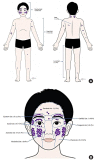Clinical analysis and review of literature on pilomatrixoma in pediatric patients
- PMID: 33143396
- PMCID: PMC7644346
- DOI: 10.7181/acfs.2020.00528
Clinical analysis and review of literature on pilomatrixoma in pediatric patients
Abstract
Background: Pilomatrixoma is a benign tumor that originates from the hair follicle matrix. It usually presents as a hard, slow growing, solitary mass that can be easily misdiagnosed as other skin masses. The aim of this study was to clinically analyze a case series of pilomatrixoma in pediatric patients from Korea.
Methods: A total of 165 pediatric patients from 2011 to 2018 with a histological diagnosis of pilomatrixoma were included. A retrospective review was performed using the electronic medical records, including patient demographics, number and location of the mass, clinical and imaging presentation, and postoperative outcomes.
Results: There were 61 male and 104 female patients with 152 solitary and 13 multiple pilomatrixomas. Among solitary pilomatrixomas, the lesion commonly occurred in the head and neck (84.2%), followed by upper limbs (11.2%), lower limbs (3.3%), and trunk (1.3%). The pilomatrixoma lesion presented as the following types based on our clinical classification: mass (56.02%), pigmentation (25.31%), mixed (12.65%), ulceration (4.82%), and keloid-like (1.2%). Ultrasonography showed a high positive predictive value (95.56%). There were no specific complications observed except for two cases of recurrence.
Conclusion: Pilomatrixoma has various clinical feature presentations and commonly occurs in the head and neck. Ultrasonography is a helpful diagnostic tool. Surgical removal of the lesion is the main treatment method with a low recurrence rate.
Keywords: Benign neoplasms; Pediatrics; Pilomatrixoma.
Conflict of interest statement
No potential conflict of interest relevant to this article was reported.
Figures





Similar articles
-
Pilomatrixoma: a review of 346 cases.Plast Reconstr Surg. 2003 Dec;112(7):1784-9. doi: 10.1097/01.PRS.0000091160.54278.64. Plast Reconstr Surg. 2003. PMID: 14663221
-
Pilomatrixoma and its Imitators.Ear Nose Throat J. 2024 Mar;103(3):183-189. doi: 10.1177/01455613211044778. Epub 2021 Sep 22. Ear Nose Throat J. 2024. PMID: 34549614 Review.
-
Pediatric Pilomatrixomas: Four Atypical Clinical Presentations.Plast Surg (Oakv). 2025 Feb;33(1):133-138. doi: 10.1177/22925503231198098. Epub 2023 Aug 30. Plast Surg (Oakv). 2025. PMID: 39876865 Free PMC article.
-
A skin tumor from an orthopedic oncology perspective: Pilomatrixoma in extremities (11 years experience with 108 cases).Dermatol Ther. 2019 Sep;32(5):e13004. doi: 10.1111/dth.13004. Epub 2019 Jul 2. Dermatol Ther. 2019. PMID: 31241214
-
Pilomatrixoma: A Comprehensive Review of the Literature.Am J Dermatopathol. 2018 Sep;40(9):631-641. doi: 10.1097/DAD.0000000000001118. Am J Dermatopathol. 2018. PMID: 30119102 Review.
Cited by
-
Eyelid Pilomatrixomas: A Case Report and Comprehensive Literature Review.Cureus. 2025 May 22;17(5):e84639. doi: 10.7759/cureus.84639. eCollection 2025 May. Cureus. 2025. PMID: 40546551 Free PMC article.
-
Pilomatricoma: Clinical, Dermoscopic Findings and Management in 55 Pediatric Patients and Concise Review of the Literature with Special Emphasis on Dermoscopy.Dermatol Pract Concept. 2024 Apr 1;14(2):e2024140. doi: 10.5826/dpc.1402a140. Dermatol Pract Concept. 2024. PMID: 38810027 Free PMC article. Review.
-
Keloid-like Pilomatricoma of the Auricle: A Case Report and Review of Literature.Case Rep Dermatol. 2022 Aug 19;14(2):230-238. doi: 10.1159/000525895. eCollection 2022 May-Aug. Case Rep Dermatol. 2022. PMID: 36158856 Free PMC article.
-
Periorbital cutaneous angiomyolipoma: a case report.Arch Craniofac Surg. 2023 Apr;24(2):83-86. doi: 10.7181/acfs.2022.01088. Epub 2023 Apr 20. Arch Craniofac Surg. 2023. PMID: 37150530 Free PMC article.
-
Pilomatricoma in the infraorbital region.Clin Case Rep. 2024 Aug 12;12(8):e9322. doi: 10.1002/ccr3.9322. eCollection 2024 Aug. Clin Case Rep. 2024. PMID: 39139622 Free PMC article.
References
-
- Malherbe A, Chenantais J. Notes on calcifying epitheliomas of sebaceous glands. Prog Med. 1880;8:826–8.
-
- Forbis R, Jr, Helwig EB. Pilomatrixoma (calcifying epithelioma) Arch Dermatol. 1961;83:606–18. - PubMed
-
- Ingraffea A. Benign skin neoplasms. Facial Plast Surg Clin North Am. 2013;21:21–32. - PubMed
Grants and funding
LinkOut - more resources
Full Text Sources

